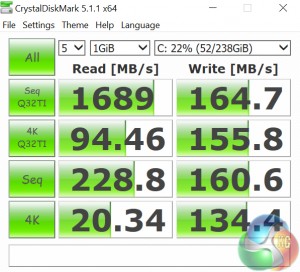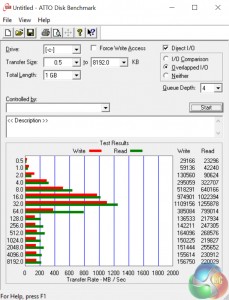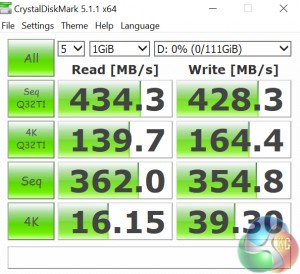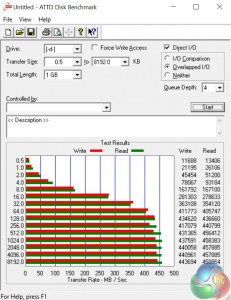M.2 interface
As users need to supply an M.2 SSD (PCIe or SATA are supported), we are not testing the speeds of the Toshiba OCZ RD400 we installed ourselves. This test is to ensure the M.2 interface is functioning at its maximum speeds.
To test this, we benchmarked our PCIe, NVMe Toshiba OCZ RD400 using CrystalDiskMark and ATTO Disk Benchmark.
Unfortunately, using a PCIe M.2 SSD with the NC02U5 is problematic. This is because there is no additional cooling for the M.2 slot – and subsequently, thermal throttling occurred. This is made clear by looking at the results from ATTO Disk Benchmark – the results were clearly on an upwards trajectory until the SSD hit a certain thermal ceiling and the speeds quickly petered out.
This is very unfortunate, as it makes using the latest NVMe SSDs, for example, almost pointless in the NCO2U5.
USB 3.0
To test the NC02U5's USB 3.0 Type-A ports, I plugged in an OCZ Trion 150 SSD via a SATA-to-USB 3.0 5Gbps adapter, which uses the ASMedia ASM1053 controller. We reviewed the SSD HERE, finding it delivers good speed at a budget price. Most importantly, it is capable of saturating the USB 3.0 bus, allowing us to test the speeds the two USB 3.0 ports delivers. To test this, I ran both CrystalDiskMark and ATTO Disk Benchmark on the Trion 150 drive.
As you can see, the USB 3.0 ports have no problem operating right at the 5Gbps USB interface ceiling.
 KitGuru KitGuru.net – Tech News | Hardware News | Hardware Reviews | IOS | Mobile | Gaming | Graphics Cards
KitGuru KitGuru.net – Tech News | Hardware News | Hardware Reviews | IOS | Mobile | Gaming | Graphics Cards






